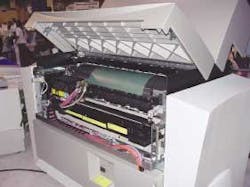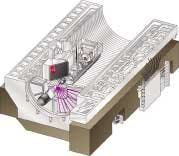For a growing number of commercial printers and publishers, the use of laser-based computer-to-plate imaging is no longer an “if” but a “when.”
or many years, offset printing plates were imaged using traditional films and high-power ultraviolet lamps, a technique now referred to as analog film-to-plate. But with the advent of laser-based prepress techniques (at about the same time that desktop publishing came into being), many printing companies began to realize that the old analog approach did not offer as much flexibility or cost savings as computer-to-plate (CTP), particularly in terms of make-ready time.
Lasers first appeared on the offset printing scene around 1980 in the form of digital image setters (known then as typesetters). Xenon and cathode-ray tubes gave way to HeNe and argon-ion lasers for exposing the photographic paper in these machines to create long galleys of typeset copy that could then be waxed and pasted up on boards prior to exposure to the film that was then used to create the printing plates (most commonly coated with an anodized aluminum substrate). A decade later, these same imaging systems began moving away from exposing single galleys of type to full pages of a magazine or newspaper, and then entire multipage flats. By the mid-1990s, the printing industry was ready to give up film completely, and the CTP business was born.
In essence, CTP is the laser exposure of a digital printing plate without a film intermediate. It can happen on-press or off-press, with or without a plate processor. Over the past decade the role of lasers in the printing industry has expanded from green platesetters driven by diode-pumped solid-state lasers (532 nm) to CTP systems powered by infrared (also known as “thermal”), violet diode, and ultraviolet lasers (see Fig. 1). Ultraviolet lasers-primarily 364-nm argon ion and 355-nm DPSS lasers-have also shown promise for large-volume high-speed printing, such as newspapers, although this market has stalled somewhat since these lasers were first introduced to the commercial printing industry in 2003. Ultraviolet-sensitive plates are cheaper than violet or thermal plates, but UV-laser imagers are so expensive that only high page volume can justify them in terms of cost.
FIGURE 2. The Galileo system from Agfa uses a violet laser diode to image plates held in place by Agfa’s patented internal drum design. The IntelliTrack slide mechanism moves the imaging system smoothly across the entire length of the drum. In operation, the light from the violet-laser source bounces off the fold mirrors and is directed by a spinning octagonal mirror through a focus lens, off another mirror, and down to the image plane of the violet wavelength-sensitized printing plate on a moving bed.
Outside of lithographic CTP, nondiode lasers continue to find application in other parts of the printing industry (see Fig. 2). For example, diode-pumped solid-state green lasers are used in holographic printing, film writing, and photofinishing, while CO2 lasers are being used increasingly for direct engraving of flexographic (flexo) plates, which are used in printing onto plastic, cardboard, foil, juice boxes, and other packaging and promotional products. In addition, UV lasers are used to direct-image printed circuit boards, while high-power Q-switched DPSS lasers are also used for direct engraving of copper cylinders used in gravure printing, an emerging market for lasers.
Violet or infrared?
In today’s prepress market, 830‑nm (IR) diode lasers are the light source of choice for thermal/IR CTP systems, while 405-nm (violet) diode lasers have begun to displace the larger 532-nm lasers for visible CTP. The infrared vs. violet debate has been a volatile one in the printing and prepress industries for the past four years, ever since violet diodes began achieving the power levels necessary to make them competitive with the more established thermal CTP technology. When they were first introduced into CTP (around 2000), commercially available violet diodes averaged 5 mW of output power; by 2002, powers had increased to 30 mW and at DRUPA 2004 (Duesseldorf, Germany) last May, 60‑mW violet diodes were “everywhere,” according to Michael Mittelhaus, a CTP consultant based in Voltlage, Germany.1
Both CTP approaches have distinct features and benefits. Thermal imaging, which utilizes IR diode-laser arrays at powers up to 50 W, is a heat-dependent process in which the laser must generate enough heat to cause the plate chemistry to change and the image to appear. Violet-laser CTP technology, like other visible light approaches, uses light to change the surface of the plate and create the active image area (see Fig. 2). Generally, thermal devices are more binary in nature, meaning that a spot is either imaged or not on a plate, and they typically require higher levels of energy to produce the necessary heat. However, thermal technology is used for imaging all three of the major press-based printing processes-offset, flexography, and gravure printing. Violet devices are less expensive and require less energy to produce the necessary light and yield the image more quickly, but the results can be less binary. In addition, violet CTP systems must be operated in a controlled lighting environment, as opposed to natural light or typical room lighting.
Another key difference between thermal and violet-laser CTP is the plates. Silver and photopolymer plates can be sensitized to the violet-diode wavelengths, while thermal plates cannot. However, the photopolymer or silver halide coatings on violet plates need to be about 3000 times more sensitive than those on thermal plates. While this sensitivity and energy savings offers advantages, they can also be drawbacks in a high-volume, fast-paced printing environment where predictable and repeatable results are required. The three major plate vendors-Agfa, Fuji, and KPG (KodakPolychrome Graphics)-all offer violet photopolymer plates, and Agfa and Mitsubishi Imaging each have silver halide-based violet plates. But the development of 60-mW violet diodes for CTP provides more latitude in exposing photopolymer plates, which means these systems now have more flexibility in terms of being able to expose both kinds of plates, according to Steve Musselman, worldwide business development at Agfa Graphic Systems.
Both types of lasers are gaining ground in the CTP market and sales of violet and IR laser diodes for commercial printing showed significant growth in 2003 and increased another 7% to $47 million in 2004, with most of that growth coming from sales of violet diodes. In the newspaper industry, for example, violet-diode CTP systems have enjoyed a surge in popularity because of their speed, durability, low cost, and high image resolution; the lower initial cost of violet devices makes them very attractive for smaller, more price-conscious printers, especially in Europe.2 At the same time, however, Vantage Strategic Marketing (Somerset, England) says that sales of thermal platesetters accounted for 64% of worldwide platesetter sales in 2003 and that thermal CTP plates represented 68% of plate consumption, which means that IR diodes are also selling well.3 In fact, Vantage predicts a maximum market share for violet diodes of 40% by 2008.
Going direct
One reason that sales of violet diodes are expected to plateau in the next few years is the push to create truly processless direct imaging techniques, also known as direct-to-press (see Fig. 3). CTP has long been predicted to make the film market obsolete; the next question is whether direct imaging technology will eventually make CTP obsolete. One major appeal of CTP is that it removes a step from the process, increasing quality and reducing cost and turnaround time. Direct imaging could take that to the next level by reducing yet another step and sending digital data directly to the press. And while both visible-light and thermal technologies can expose plates, thermal currently remains the only practical way for a printer to adopt processless plates.
FIGURE 3. Processless platesetters, enabled by more-compact laser heads, can be mounted directly on a printing press, allowing pages to be sent directly to the press for imaging prior to printing. This approach saves time and money by eliminating the need for a separate plate processor and the related chemicals.
“It will take another four or five years, but thermal will ultimately dominate because it is the one that can be truly processless,” said Greg Niven, director of marketing, graphic arts and display at Coherent (Santa Clara, CA). “You can’t do processless imaging (with violet) because of the energy densities. And the market will also want thermal because it is cheaper.”
At DRUPA 2004, several plate manufacturers-including Agfa, Kodak, Fuji, Presstek, and Creo-made processless announcements or hosted processless technology demonstrations. The benefits of processless include improved productivity, reduced costs, and reduced cycle time, with fewer steps in the platemaking process, the elimination of chemical developing, reduced energy consumption, and significantly reduced environmental impact. Although processless plates are generally priced higher than standard plates, the argument in their favor is that elimination of these other costs (and reduction of cycle time), which can comprise up to 35% of the total cost of plate production, easily justifies the higher cost per plate. In addition, elimination of the chemical processor unit reduces space consumption, a huge consideration for smaller printers.
“One of the promises of thermal technology using the 830 or even 1064 nm is that it would enable processless imaging with no chemical development to demonstrate the lithographic properties on press,” Musselman said. “The theory is that thermal lasers could change the state of the surface. This technology is starting to come out now, but it requires a lot of energy.”
Print quality is critical
Whether a CTP system manufacturer opts for IR, violet, green, or any combination thereof, the technical demands placed on these lasers by the printing industry are great. Regardless of their size or the type of work they do, all printers, depend on plate-imaging accuracy, consistency, and repeatability. Eliminating variables is a key component of their print-manufacturing process that makes basic business sense. The promise of CTP is to deliver consistency, yet by their very nature, visible-light CTP systems exhibit greater potential for plate-imaging variation. Ultimately, plates imaged using visible-light CTP can exhibit inconsistencies similar to those of a film-based workflow, adding to cost.
All of these challenges-plus a very price-conscious customer base-have put laser-diode manufacturers to the test in recent years. Infrared- and violet-diode technology used in CTP was developed for other applications, but the technical specs are much higher in the graphic arts. They must possess the lowest noise of any laser products, have extremely reliable beam pointing, and offer very high reliability-along the lines of 15,000- to 20,000-hour lifetimes.
“The printing industry is very cutthroat, and print quality is critical,” Niven said. “The eye is very adept at picking up patterns, such as microbanding. And thermal-based setters allow photographic-quality printing.”
Looking ahead, processless imaging will put even more pressure on violet lasers because it requires far more energy than conventional imaging. The power required is in the range of 40 W, which is within the capabilities of current thermal imaging systems but hundreds of times beyond that of current violet lasers (40 to 60 mW). Some analysts predict the emergence of higher-powered violet lasers, but even the most optimistic expectations fall well below the requirements of processless emulsions. Violet laser-based processless plates are expected to eventually become a reality, but not before 2006, and not with current CTP devices. In the meantime, Fuji and CitiPlate have already announced violet diode-based processless plate technologies, and other plate companies are expected to follow suit in 2005.
REFERENCES
1. M. Mittelhaus, PrintWeek (June 24, 2004). R. Woods, Presstime (October 2004). ‘Direct‑to’ Tech. 2004, Vantage Strat. Market. (July 2004).


